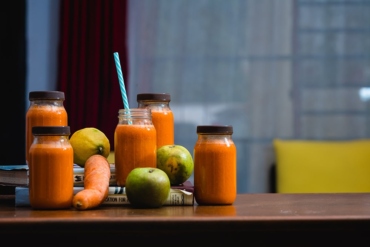To curb the summer heat, many of us turn to juicing or pulping for refreshment and hydration. Juicing is an easy way to assimilate all the vitamins and minerals that would normally take an hour to digest after eating fruits and vegetables.
Our bodies can uptake the powerful enzymes and phytochemicals from juiced veggies and fruits in only 15 minutes. Rich in vitamins A, C and E, along with minerals like iron, potassium, iodine, magnesium and selenium, juices are incredibly easy to digest, saving the body much time and energy. It allows for the body to rest while detoxifying and cleansing itself.
In with the Good, Out with the Bad
Our cells are composed mainly of water. Juicing, along with ideal water intake, aids to replenish lost fluid on a hot day, provides the body with the necessary vitamins and minerals, alkalizes our body (for ideal PH balance) and is vital for proper immune and metabolic function. Furthermore, juicing is rich in chlorophyll, a unique structure that enhances the body’s ability to produce hemoglobin. Raw juice has a laxative effect, which aids the body in detoxification. It rids the body of unwanted toxins in the digestive tract and colon. It has been known to restore an unbalanced metabolism, stabilize mood, clear the skin, and generally make one feel lighter.
Juice is rich in antioxidants, which counteract the free radicals that can cause cellular damage, aging and susceptibility to cancers. Yes, raw juice contains natural sugars, and may not be suitable for all individuals (considerations include diabetes, hypoglycemia and metabolic issues), and should always accompany a well-balanced diet. The sugars that are typically found in raw juices are bundled from the fruits and raw veggies that are rich in enzymes, vitamins, minerals and other phytochemicals. You won’t find these in refined sugar, e.g. store bought juices, soft drinks, candies and pastries; these natural sugars will deliver energy without the nasty chemicals or fat. That said, juicing alone is not ideal for your overall health and wellness. As juicing diets are complex in nature, they should be done under the supervision and guidance of a health care provider (a naturopathic doctor or a registered nutritionist).
Juicing versus Pulping
Raw juicing or pulping is best, for these contain “life force,” a living power that is present in all living plants. This force is a natural, vital quality that is lost when juices are processed and stored. In pulping, the fibre of the fruits and vegetables is blended into the drink. When fruits and veggies are pulped, their fibre is retained, along with their incredible vitamins, minerals and phytochemicals, much like in juicing.
Personally, I prefer pulping to juicing, as the fibre (cellulose, pectin, lignin an hemicellulose) is the powerhouse ingredient for lowering cholesterol, and reducing the risk of heart disease and cancers. It binds onto unwanted toxins and detoxifies the body, works to keep you feeling fuller for longer, and balances blood sugar irregularities. Moreover, insoluble fibre assists in colon health, and works to maintain ideal body composition and a healthy waistline!
Tip: green juices are best consumed through a straw. Blends that are made with dark leafy greens, lemons or beets contain pigments that can build up on your tooth enamel and can stain your smile.
Recipes
Serving size for 2
Detox Tonic
• 3 fresh dandelions (roots and leaves)
• 2 radishes
• 1 handful of watercress
• 1 handful of arugula or kale
• 1 apple
• 1/2 lemon
• 1/2 inch of ginger root
Cucumber Chiller
• 1 cucumber
• 2 cups green grapes
• 1 handful of fresh mint
• 2 apples
• 1/2 lime
For optimal results, juice with organic and local produce and consume the juices as soon as they are prepared.


